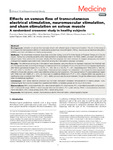Effects on venous flow of transcutaneous electrical stimulation, neuromuscular stimulation, and sham stimulation on soleus muscle: a randomized crossover study in healthy subjects

Ver/
Use este enlace para citar
http://hdl.handle.net/2183/31723
A non ser que se indique outra cousa, a licenza do ítem descríbese como Creative Commons Attribution-NonCommercial 4.0 International License (CC-BY-NC 4.0)
Coleccións
- Investigación (FFISIO) [473]
Metadatos
Mostrar o rexistro completo do ítemTítulo
Effects on venous flow of transcutaneous electrical stimulation, neuromuscular stimulation, and sham stimulation on soleus muscle: a randomized crossover study in healthy subjectsAutor(es)
Data
2022-09-02Cita bibliográfica
Senin-Camargo F, Martínez-Rodríguez A, Chouza-Insua M, Raposo-Vidal I, Jácome MA. Effects on venous flow of transcutaneous electrical stimulation, neuromuscular stimulation, and sham stimulation on soleus muscle: a randomized crossover study in healthy subjects. Medicine (Baltimore). 2022 Sep 2;101(35):e30121.
Resumo
[Abstract] Background: Activation of venous flow has been shown with different types of electrical stimulation. The aim of this study is to compare the hemodynamic effects of transcutaneous electrical nerve stimulation (TENS), neuromuscular electrical stimulation (NMES), and sham stimulation on healthy young people.
Methods: This randomized crossover study was conducted during June 2018 in the Faculty of Physical Therapy of A Coruña (Spain). Twenty-four university students (50% male) received in a randomized order 5 Hz-TENS, NMES, and sham stimulation on soleus muscle. Flow volume (FV) and peak velocity (PV) from popliteal vein were recorded via Doppler ultrasound, and relative changes from baseline were determined. Discomfort among the 3 stimulations was also compared.
Results: The differences among the 3 stimulations were assessed using the ANOVA for repeated measured, the Friedman test and the Kendall tau test, according to the type of measurement to be compared. FV (mL/min) and PV (cm/s) increased significantly after NMES (percentual increase 37.2 ± 62.0%, P = .002; 264.4 ± 152.2%, P < .001, respectively) and TENS (226.2 ± 190.3%, P < .001; 202.7 ± 144.6%, P < .001, respectively). These percentual changes from basal level in hemodynamics were statistically different to those after placebo, which was ineffective enhancing hemodynamics. The improvements in FV were statistically higher with TENS than with NMES (P < .001), but there was no statistical difference in PV (P = .531). Despite NMES was applied at a significantly lower amplitude than TENS (P < .001), NMES protocol was the worst tolerated, though the differences in discomfort were not statistically significant.
Conclusion: Both active electrical protocols but not sham stimulation increased hemodynamics in healthy people. TENS obtained higher flow volume increase from baseline than NMES, considered globally at not only in its on-time.
Palabras chave
Hemodynamics
Placebo
Transcutaneous electric nerve stimulation
Ultrasonography Doppler
Placebo
Transcutaneous electric nerve stimulation
Ultrasonography Doppler
Versión do editor
Dereitos
Creative Commons Attribution-NonCommercial 4.0 International License (CC-BY-NC 4.0)
ISSN
0025-7974






